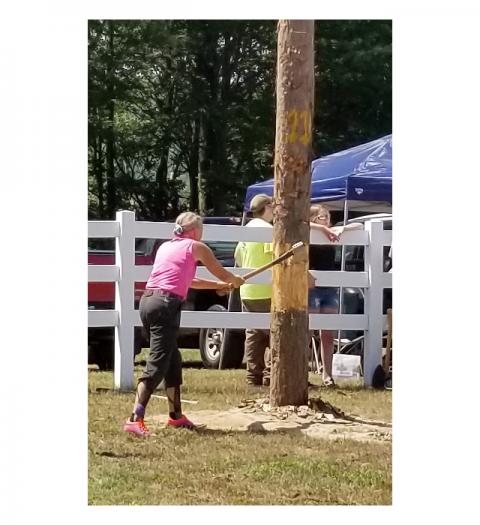Logging Then and Now

Last weekend at the North Haverhill Fair, I helped out at the Rich Kinder Memorial Woodsmen’s Competition, which celebrated its 22nd year. Rich was a much loved and well-respected county forester, as seen by the numerous family members and others who have helped keep the competition going for all these years, and the small army of volunteers in attendance.
Old Logging Skills
Most of the events were based on old logging skills using the tools of the trade. The events included log rolling with peaveys, timed cutting with bow saws and two-person crosscut saws, horizontal chop of a squared timber with an axe, and tree felling with an axe.
These old skills are kept alive through sport, but in the early days of logging in this country, these skills and tools accomplished a tremendous amount of work. When one thinks about how much timber was felled and sent to market with hand tools, along with plenty of human and animal muscle, it’s almost difficult to fathom. Millions of board feet of sawtimber and millions of cords of pulpwood were felled and brought to market with axes, crosscut saws, bow saws, and other hand tools, along with oxen and horses and the many specialized tools related to animal power. Not only did the work of bringing timber to market require plenty of strength, it also required plenty of skill and ingenuity.
An Evolving Industry
Over the years, logging has evolved with advances in technology, differences in conditions in the woods, diminishing average tree size, changes in products that can be made from wood, and changing market demands. The technology used in logging today would be unrecognizable to the woodsmen of old. One thing that hasn’t changed, however, is the need for skill and ingenuity. The tools and skills have changed, but modern loggers need to be just as proficient with their tools as the loggers of yesteryear had to be with theirs. In many ways, today’s logger needs to be much more skilled than his 19th and early 20th century counterpart. In the old days, a woodsman could be, and usually was, a specialist. He specialized as an axe man, a teamster (the person who handled the teams of oxen or horses used to get the timber out of the woods), a scaler (wood measurer), timber cruiser, river driver, or other job. Today’s logger needs to possess numerous skills, including felling trees, operating, maintaining, and repairing equipment, estimating timber, marketing wood, negotiating contracts, working with foresters, landowners, and wood buyers, running a business, and any number of tasks needed to keep operating.
Modern Logger Training
To that end, last week I visited the School of Logging at Paul Smith’s College in New York’s Adirondacks, a region that is equally rich in logging history as New England. The college’s forest manager, Dave Falkenham (former Grafton County Extension forester) helped start the School of Logging, and he generously gave his time to discuss the School with me and Steve Gaines from New Hampshire Timberland Owners’ Association.
Just as in the past, skilled loggers are needed in the woods today. Unlike in the past, however, fewer people are joining the logging profession. At the height of the original lumbering era, people came from many places to work in the forest industry. In addition to New England and Quebec, people came from England, Ireland, Russia, Poland, Germany, Sweden, Finland, and Norway to work in the woods, on river drives, and in sawmills.
Today, the logging workforce is aging, and fewer young people are entering the profession. This is for a variety of reasons, one of which is misperceptions about what logging involves. It has always been a challenging trade, but logging today involves far less sheer physical labor than it once did. Modern logging involves operating and maintaining sophisticated, expensive machines that require knowledge of hydraulics, electrical systems, and diesel engines. Logging needs to be done in accordance with environmental regulations, and in such a way that protects the trees to be grown for the future, soil and water, wildlife habitat, and aesthetics. All this needs to be accomplished while merchandising the harvested trees for the highest value and making a profit.
Though the overall logging force is getting older, there were 13 eager young students at this year’s School of Logging, ranging in age from late teens to early twenties. The aim of the four week program is to introduce students to the principles of the modern logging profession, and to train them in some of the skills needed to work on a logging crew. Students were trained in tree felling, chainsaw maintenance, first aid, personal protective equipment, and equipment operation and maintenance. During the second half of the school, the students worked with a logging contractor on an actual timber harvest. They were responsible for felling trees, skidding them to the landing, and cutting them into logs bound for various mills, and they needed to do all of these things as efficiently as possible while leaving the land in good condition. Just as real loggers need to do every day. The students worked under the close supervision of the instructors, which included the contractor and equipment operators. The instructors were all dedicated to the proper training of the next generation of loggers.
Still a Vital Industry
The logging industry has gone through many changes over the last 300 years. Logging technology has evolved from felling trees with axes and crosscut saws, bucking them into lengths with crosscut saws and bow saws, and bringing them out of the woods with oxen and horses and to the mills via streams and rivers. Along the way the chainsaw, bulldozer, and rubber-tired skidder were developed and brought into use, and equipment used to load logs evolved from using cable systems to hydraulics. Engines went from being powered by steam to gasoline to diesel. Today’s logging equipment is highly engineered for power and efficiency while being as light on the land as possible.
Desired trees in the marketplace changed from large white pines for ship masts in colonial times to hardwood veneer and sawlogs, in addition to softwood sawlogs, today. In the early days, there were only markets for lumber, so trees that weren’t of lumber quality weren’t harvested. Technology was developed that made wood fiber efficient for papermaking. At first spruce and fir were the desired species, but gradually hardwoods became the preferred fiber, and trees of any quality could be used. Markets for softwood pulp became almost non-existent in recent years. Other recent changes include the reduction of papermaking and the subsequent loss of markets for millions of tons of pulpwood, and the decline of biomass chip markets.
Through all the changes, the need for wood as a basic material of society has remained, and we continue to develop new uses for it. Despite the ups and downs in the markets, and the sometimes seemingly dire status of the industry, there will always be a need for renewable, versatile wood, and skilled loggers to harvest it.
